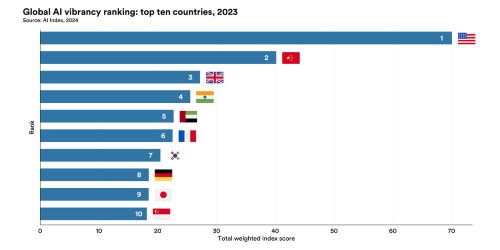United States, China, and United Kingdom Lead the Global AI Ranking

The Stanford Institute for Human-Centered AI (HAI) AI Index today released its Global AI Vibrancy Tool which allows flexible comparisons of 36 countries based on 42 openly available AI-specific indicators. Comparisons between countries can be made using either absolute or per capita versions of the indicators and are supported by interactive visualizations.
The Global AI Vibrancy Tool measures the strength of the AI ecosystems based on 8 pillars — research and development, responsible AI, economy, education, diversity, policy and governance, public opinion, and infrastructure — with indicators including AI journal publications, total AI private investment, AI legislation passed, and foundation model datasets.
It is designed to empower policymakers, industry leaders, researchers, and the public with actionable, data-driven insights into national AI development that allows audiences to explore the findings in a way that’s most relevant to their goals. Policymakers can use the tool to strategically guide policy decisions, enterprises can gain insights into global AI market trends, and the general public can access concrete data to better understand the evolving debates around AI.
The Global AI Vibrancy Tool is available now at https://aiindex.stanford.edu/vibrancy/. The Stanford HAI AI Index hopes to further encourage global stakeholders to improve their data collection and sharing efforts in the interest of improving visibility into the global AI ecosystem. Regular updates will ensure the tool remains a valuable resource for tracking global AI development.
Using a set of weights determined by a panel of experts, this year’s top ten countries are as follows:
- United States: the U.S. leads the ranking by a significant margin and excels in the research and development (R&D) and in the AI economy pillars. The U.S. consistently produces the most notable AI machine learning models, attracts the highest levels of private AI investment, and leads in publishing responsible AI research.
- China: China demonstrates substantial strengths in the R&D, economy, and infrastructure pillars. China’s focus on developing cutting-edge AI technologies and increasing its R&D investments has positioned it as a major AI powerhouse.
- United Kingdom: the U.K. demonstrates particular strength in the R&D, education, and policy and governance pillars.
- India: India has strong performance in R&D and recent improvements in the economy pillar.
- The United Arab Emirates: The U.A.E. scores highly on the economy pillar.
- France: France ranks sixth and shows strength in the policy and governance, education, and infrastructure pillars.
- South Korea: South Korea ranks seventh, scoring highly in the policy and governance, infrastructure, and public opinion pillars.
- Germany: Germany ranks eight, showing strength in the R&D, responsible AI, and education pillars.
- Japan: Japan demonstrates strong performance in the infrastructure, R&D, and economy pillars.
- Singapore: Singapore shows strength in the economy, diversity, and responsible AI pillars.
“AI has increased as a topic of national interest, and correspondingly narratives about which countries lead in AI have become more prominent than ever,” said Nestor Maslej, Project Manager of the AI Index. “However, there’s limited data providing a clear, quantitative view of where countries actually stand in AI. At the Index, we wanted to address this gap with a rigorous tool that could help policymakers, business leaders, and the public ground these geopolitical AI narratives in fact.”
Last Updated on 2 months by News Desk 1












